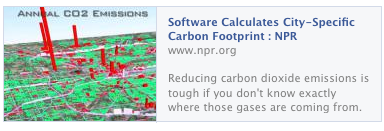Joy brought up another good question while we were having lunch the other day: if a person wanted to reduce their carbon footprint, what change would have the most impact?
Most resources agree that reducing motorized travel of any kind would have the biggest impact on overall carbon emissions reduction. Chris Goodall puts a finer point on the matter in his book How to Live a Low-Carbon Life by saying “the only really significant change to our lifestyle that we need to make to get our carbon emissions significantly lower is to cease to travel by air.” Wow. Cease. Cannot imagine a world without any air travel. I could see it significantly reduced, but ceased? Eek.
Let’s take a 3,000 ft look at what Chris Goodall outlines as the most critical changes a person can make, then let’s look at some CO2 calculators and see where I end up, carbon-wise.
What can you do to reduce your CO2 output now?
- Cease air travel (ouch!)
- Drive your car less. (No need to rush out and by a hybrid. Producing cars produces CO2, so hold on to that clunker as long as possible – a little counter intuitive, but it works for me.) Small aside. If you need motivation to drive less, take a look at the Hestia project where scientists put CO2 probes all over a city to measure street and building emissions – the landscape actually breathes with CO2.

- Food. “Buy organic when possible, local when available, keep away from processed and packaged food, and most important of all, buy less meat and dairy products.” Wow. Less meat and dairy – that’s what America runs on. Apparently, “the energy used to provide food to our tables is nine times greater than the caloric value of the food itself.”
- Use trains and long-haul buses. City buses stop and start a lot which apparently wipes out some of their efficiency and rural country buses that run almost empty aren’t doing much either.
- Turn your heat down, to 65F/18C degrees, if you can. We have ours set at 68F/20C and it seems chilly enough. (I’m wearing two sweaters as I type this.) We turn it down to 55F at night – get points for turning heat down at night. Warmer climates need to consider their air-conditioning use as well.
- Household appliances that use the most energy are: clothes dryer, refrigerator and washing machine. Next inline is that large flat-screen TV, not a big surprise.
- Keep things longer. I’m down with this concept. It costs more in CO2 emissions to make new computers and cell phones than to upgrade to a more energy-efficient models.
- Buy used clothing whenever possible.
- Basically, consume less material things. As a non-shopper, that sounds good to me!
Those are the broad strokes from Chris Goodall’s book. Next, I’ll look at some carbon-calculator results.



JANE!! Lisa told me about your site and I just found it. This is great! Great writing and some great ideas! Ive started the blog above and invite you to take a look. We need to connect over some low-carbon synergy :-).
Deb! Clearly we’re on the same wave length. Good to see you at the zero waste meeting – better than watching TV that’s all I have to say. Yes, would love to get together and talk a little low carbon. Congrats on the new blog. Fun, right?